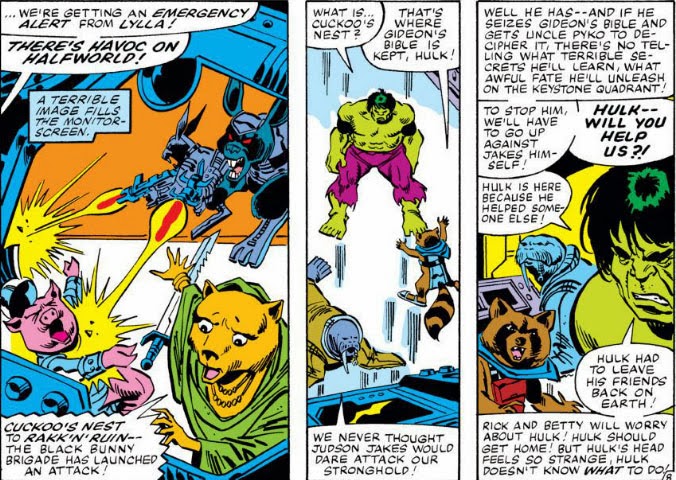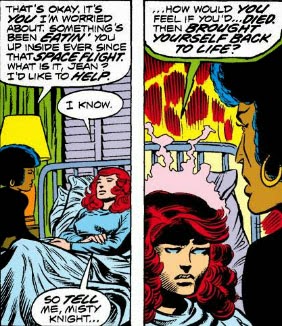The
last time we looked in on Jean Grey, she had died.
"Again," you quickly point out. All right, fair enough.
This would make three times Jean had died--though technically it was only twice, since her first death was as the Phoenix while duplicating her form. The Phoenix was more directly involved with Jean (on some level) in her second death (her first "true" death), and more fully merged with her when she died
again at the hand of Magneto. I can see your eyes glazing over at this point, and I'm right with you--it all seems so ridiculous when you see it on paper like this. "Only twice." Good grief.
Let's go back a bit to when Jean was recovering from her first transformation into Phoenix (though at the time she actually
was Phoenix while
thinking she was Jean, but for pity's sake let's not get into all
that again). "Jean" asked a question which would echo its way through her convoluted history with Phoenix and land at the doorstep of where we are now:
At the time, "Jean" was under the mistaken impression that she had indeed died on that space shuttle (which I guess might count as
another death, eh? Oboy.), but the question never really applied until Wolverine ended her life aboard Asteroid M--after which, Jean and Phoenix were reborn in a state of co-existence. This time, with both Jean and Phoenix aware of each other, Jean was on board with being Phoenix (or, rather,
hosting Phoenix), and seemed to set aside any concerns about being brought back from the dead.
Jump ahead to a year (in publication time) after that story concluded, where a new series continues the story of Phoenix, and Jean will be forced to more directly confront the implications of rising from the grave. And the X-Men will find themselves caught up in the struggle.
In
X-Men: Phoenix - Endsong, a few things have to occur before the story can proceed. How to bring back the Phoenix, and how to involve it with the X-Men again? To put the story in motion, we have a group of Shi'ar who don't seem to know how to leave well enough alone. They're hunting for and have found the Phoenix force, and they make ready to attack it--but in this scene, we discover their hands aren't exactly clean:
Yes, you read that correctly--after all this time of having
no Phoenix to worry about, they've gone to the trouble of bringing it back so that they can then turn around and try to destroy it. Normally, that wouldn't make any sense whatsoever, and certainly doesn't seem like a plan that would hold water with the Shi'ar government; but these appear to be rogue agents, and we'd learn later that the instigator of this plan had lost loved ones in the D'Bari system where Dark Phoenix wiped out five billion people. So it's basically a vendetta we're talking about here, and a dangerous one--to risk once again endangering the universe in order to settle a grudge.
They also have a counselor with them who warns of the consequences of their actions, though he might have spoken up before their plan actually went into effect; but someone should also point out to him that the "heart" of the Phoenix (i.e., Jean) is what caused it to kill on such a scale in the first place, and wasn't as mitigating as he seems to believe.
Whatever process they used to reconstitute the Phoenix, it's left the entity unfocused and unable to deal with the attack the Shi'ar have formulated: creating a miniature black hole, which draws in and consumes the Phoenix. But a spark of the Phoenix has survived, enough to see to its survival by seeking out the one being it believes might restore its focus and help it to regain its power--Jean Grey. When it arrives on Earth, it inadvertently makes the X-Men aware of its presence--Wolverine, the Beast, the three telepathic proteges of Emma Frost known as the "Stepford Cuckoos," as well as the energy form of Quentin Quire, an Omega-level mutant who had caused a riot at Xavier's school. Of course, two people in particular are forced to deal with the ramifications of "Jean's" return on a more personal level:
The Phoenix finds that it isn't strong enough to take on Jean's form, as it did before--and so it ends up taking rather gruesome action in order to secure its former host.
This story obviously sets aside any precedent Marvel has established about reanimating the dead--specifically, that the person's soul would remain irretrievable, and thus only a shell is brought back to "life." Here, whatever timetable the dead adhere to for moving on seems undefined in Jean's case, leading us to believe that either the Phoenix is "life incarnate" across the board, or that Jean herself has unresolved issues that tether her to the mortal plane. Neither conforms to similar examples of reanimation we've seen in prior stories--for instance, where Captain Marvel regains his lost love, Una:
Or when the enigmatic being "Her" pursues a mission to bring back from the dead a being she considers her perfect mate, Adam Warlock:
As for Jean, what's done is done. But the situation is complicated by the fact that Jean's love affair with Scott Summers is ended--and with Phoenix still drawing on its past memories of Jean and still coveting that relationship, the desires of Phoenix to "reclaim" its life as Jean make the entity a danger to not only the X-Men, but possibly in time to others, as well. And so Jean covertly works against the Phoenix, attempting to make Logan understand that danger by making clear that she and Phoenix are not on the same page here:
Meanwhile, the Shi'ar have realized that the Phoenix has survived their trap and have tracked the fragment of Phoenix to Earth. We also learn through their analysis that Phoenix is just shy of having both oars in the water, thanks to their reckless plan:
The X-Men are also confirming the presence of Phoenix in their midst--and, with a trip to the cemetery, they face the realization that it's bonded with Jean once again, despite Scott's skepticism.
And finally, our last piece of this evolving puzzle--Quentin, who has reformed his physical body and learned that a young telepath that he had a crush on, Sophie, is now dead. And he, like the X-Men, also visits the cemetery to get confirmation at the grave--but we see that he intends for the Phoenix to play a role in easing his anguish:
And so, by the middle of this series, things are about to heat up on several levels. The Shi'ar are coming after Phoenix. They've also detected an Omega-class mutant--Quentin--whom they fear the Phoenix might seek out as a host, and they plan to end his life before that happens. Quentin, as we've established, is making a beeline for Phoenix, in order to have it bring Sophie back to life. But, what of the X-Men? If they manage to locate Phoenix, how can they stop her? And how will Jean be able to affect the outcome, one way or the other?
So far, it's difficult to get past the belief that this story is putting all of its stock in the shock value of readers seeing Jean blatantly brought back from the dead and involved with Phoenix again. Next time, we'll see if there's more to this drama than meets the eye.






























































































































































































































































